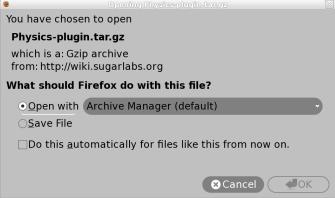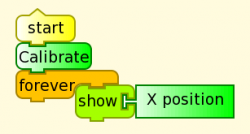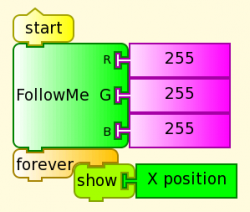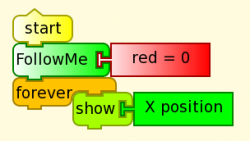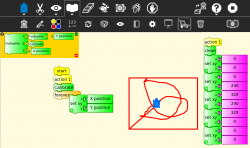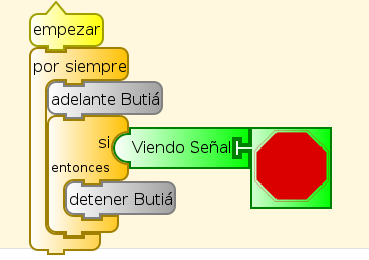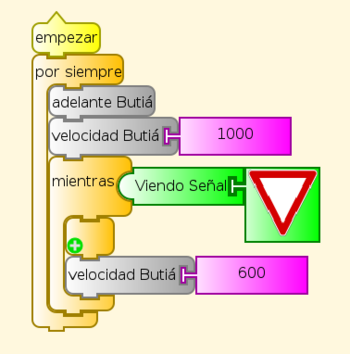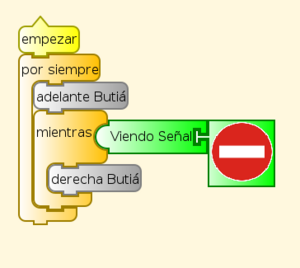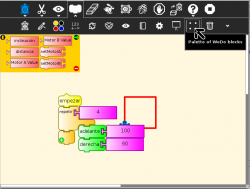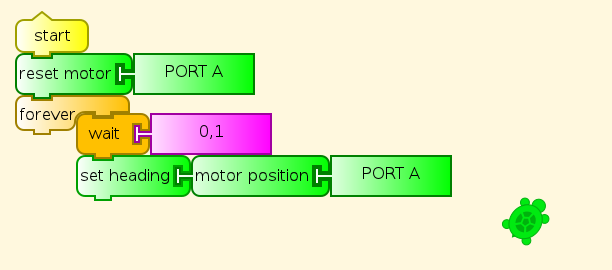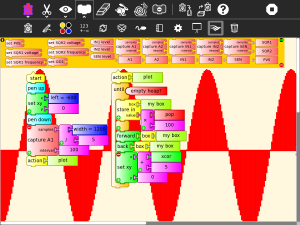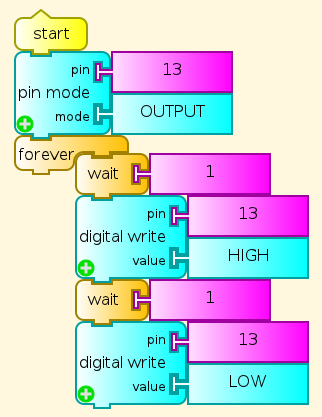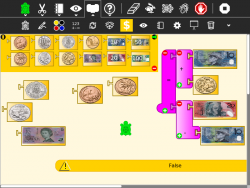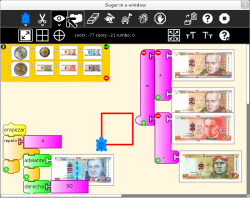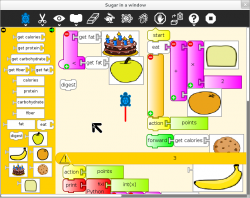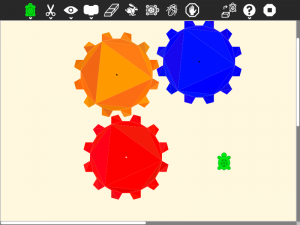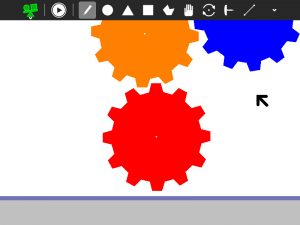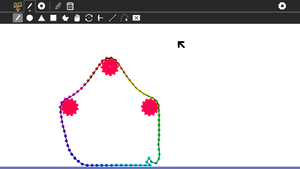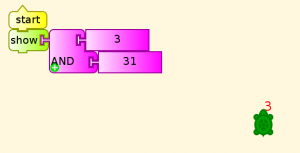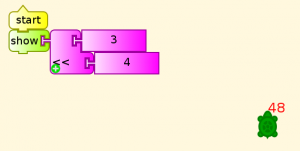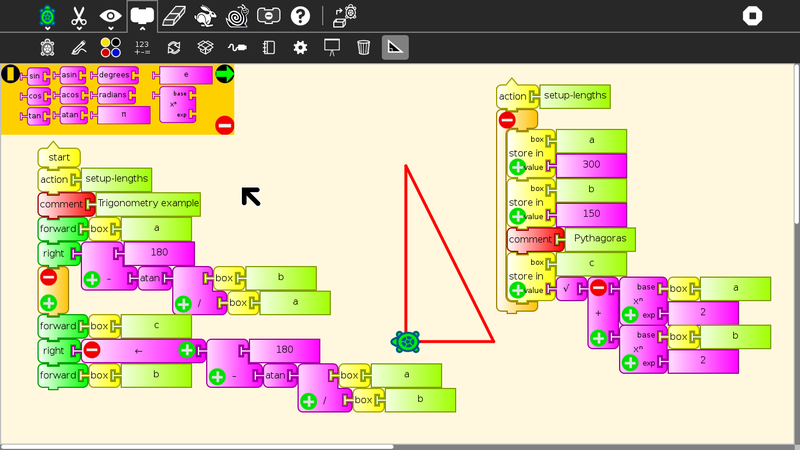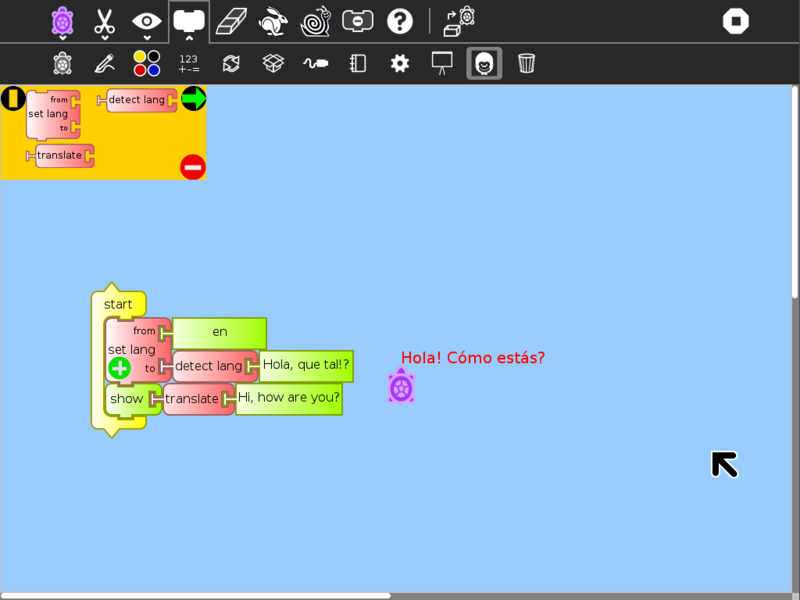Difference between revisions of "Activities/Turtle Art/Plugins"
(→Butia) |
|||
| (101 intermediate revisions by 9 users not shown) | |||
| Line 4: | Line 4: | ||
The plugin mechanism is currently used to provide support for sensors, the camera, RFID, and the Media, Extras, and Portfolio palettes. A plugin has been [http://lists.sugarlabs.org/archive/iaep/2011-March/012715.html developed for WeDo] [http://tonyforster.blogspot.com/2012/01/wedo-plugin-for-turtle-art.html (and here)] and additional plugins are being developed for Arduino, NXT, and GoGo. | The plugin mechanism is currently used to provide support for sensors, the camera, RFID, and the Media, Extras, and Portfolio palettes. A plugin has been [http://lists.sugarlabs.org/archive/iaep/2011-March/012715.html developed for WeDo] [http://tonyforster.blogspot.com/2012/01/wedo-plugin-for-turtle-art.html (and here)] and additional plugins are being developed for Arduino, NXT, and GoGo. | ||
| + | |||
| + | '''NOTE''': As of Version 193, it is necessary to use a set of refactored plugins. These will be posted to the wiki ASAP. | ||
===How to install a plugin=== | ===How to install a plugin=== | ||
| − | Plugins are typically distributed as a *.tar.gz archive | + | Plugins are typically distributed as a *.tar.gz archive. |
| + | |||
| + | In versions 137+, there is a built-in method for installing plugins from Turtle Art itself: | ||
| + | # Download the plugin to your Sugar Journal, a USB key, or $HOME/Documents. | ||
| + | # Click on the 'Load plugin' button found on the Activity toolbar. | ||
| + | # Select the plugin downloaded in Step 1. | ||
| + | # Go to the Palette toolbar to confirm that the plugin has installed and loaded properly. | ||
| + | |||
| + | In early versions of Turtle Art, please follow these instructions: | ||
[[File:Archivemanager.jpg]] | [[File:Archivemanager.jpg]] | ||
| Line 26: | Line 36: | ||
Note that you should not need root access to install plugins into your home directory. | Note that you should not need root access to install plugins into your home directory. | ||
| + | |||
| + | ===How to uninstall a plugin=== | ||
| + | Your plugin is installed in a subdirectory of | ||
| + | |||
| + | /home/olpc/Activities/TurtleArt.activity/plugins | ||
| + | |||
| + | In Terminal or Gnome, delete that subdirectory. You may need to make the Activities directory writeable first, in Terminal type | ||
| + | |||
| + | chmod 777 /home/olpc/Activities | ||
===Available plugins=== | ===Available plugins=== | ||
| Line 34: | Line 53: | ||
* rfid (This plugin allows interfacing with a RFID reader) | * rfid (This plugin allows interfacing with a RFID reader) | ||
| − | ==== | + | ====Xevents==== |
| + | Xevents it's a plugin for make accesibility interfaces in an easy way. | ||
| + | |||
| + | [[File:Xpalette1.png]] | ||
| + | |||
| + | =====GIT code===== | ||
| + | http://sourceforge.net/p/butia/code/ci/master/tree/turtlebots/xevents/ | ||
| + | |||
| + | =====Download===== | ||
| + | http://www.fing.edu.uy/inco/proyectos/butia/mediawiki/index.php/Archivo:Xevents.tar.gz | ||
| + | |||
| + | =====Wiki===== | ||
| + | http://wiki.sugarlabs.org/go/Xevents | ||
| + | |||
| + | ====Butia==== | ||
Add a palette to control the Butiá robot | Add a palette to control the Butiá robot | ||
| − | [[File:butia_palette.png| | + | [[File:butia_palette.png|1050px]] |
| − | + | And a extra palette to control the hacks pin of USB4Butiá board and special sensors: | |
| − | Download | + | [[File:butia_palette_extra.png|1050px]] |
| + | |||
| + | Andrés Aguirre is part of the Butiá team in Montevideo: | ||
| + | :We have released the 1.0 version of the sources, which has full integration with tortugarte (http://www.fing.edu.uy/inco/proyectos/butia/publicaciones.html). Last month we gave away nearly 30 Butiá robots in a robotic event organized by the University. These robots were given to secondary schools throughout the country, in this event we gave some tutorials and exercises to do with our help. One of the schools made a great line follower in tortugarte ;) : http://www.youtube.com/watch?v=Szp0LWLyPIg Then on the second day we give some tutorials and some children really enjoyed the experience, like Pedro a 10 year old child who really has programming skills! http://www.flickr.com/photos/butiarobot/5059177334/ http://www.youtube.com/aguirrea#p/u/7/p0y11iyhFko | ||
| + | :In future months we will go to the schools where we give the robots to continue teaching and giving new challenges. If you would like to see more about Butiá, we have a flickr site: http://www.flickr.com/photos/butiarobot/ and also a web page: http://www.fing.edu.uy/inco/proyectos/butia | ||
| + | |||
| + | Ceibal has this publication (in Spanish): [https://www.google.com/url?q=http://valijas.ceibal.edu.uy/storage/app/media/Guias%2520de%2520uso/Turtlebots.pdf&sa=D&ust=1518962161565000&usg=AFQjCNFsTETjQ_25Fz-hX9giAVz-YRLIyQ] | ||
| + | |||
| + | Butiá is also featured in a short film by Antel [http://www.adinettv.com.uy/video/2932] (go to 1:30). | ||
| + | |||
| + | [http://www.fing.edu.uy/inco/proyectos/butia Proyecto Butiá] (in Spanish) , [[Activities/TurtleBots]] (in English) | ||
| + | |||
| + | =====GIT code===== | ||
| + | |||
| + | [http://sourceforge.net/projects/butia/?source=directory Butia in SourceForge] | ||
| + | |||
| + | =====Download===== | ||
| + | |||
| + | [http://www.fing.edu.uy/inco/proyectos/butia/files/plugins/butia_plugin.tar.gz butia_plugin.tar.gz] | ||
====FollowMe==== | ====FollowMe==== | ||
| Line 48: | Line 99: | ||
This plugin uses the camera and get the position of an object of a color. | This plugin uses the camera and get the position of an object of a color. | ||
The plugin add this palette: | The plugin add this palette: | ||
| − | [[File:turtleart-followme-palette2.png| | + | [[File:turtleart-followme-palette2.png|1050px]] |
| − | |||
| − | |||
| − | Examples | + | =====Examples===== |
The "classic" use: on "Start", use the "Calibrate" block to open a window that shows the camera output. In the center of that window there is red square. The FollowMe Plugin uses an algorithm that obtains the "promedial" color of the object in the square. The result of that algorithm is shown in a small square in the corner. When you consider that the color is a good "representation of the object", press any key, the window will close, and FollowMe will use this color. After calibration, you can use the "X position" and "Y position" blocks. The block "X position" is the "center" of the object seen by the camera along the "X" (horizontal) axis. This value is an integer between 0 and 320. When the object is not detected,the algorithm returns -1. The operation of the "Y position" block are the same, but returns the position respect the "Y" (vertical) axis. The value returned is between 0 and 240. | The "classic" use: on "Start", use the "Calibrate" block to open a window that shows the camera output. In the center of that window there is red square. The FollowMe Plugin uses an algorithm that obtains the "promedial" color of the object in the square. The result of that algorithm is shown in a small square in the corner. When you consider that the color is a good "representation of the object", press any key, the window will close, and FollowMe will use this color. After calibration, you can use the "X position" and "Y position" blocks. The block "X position" is the "center" of the object seen by the camera along the "X" (horizontal) axis. This value is an integer between 0 and 320. When the object is not detected,the algorithm returns -1. The operation of the "Y position" block are the same, but returns the position respect the "Y" (vertical) axis. The value returned is between 0 and 240. | ||
| Line 75: | Line 124: | ||
[[File:turtleart-followme-example-ongoing.png|250px]] | [[File:turtleart-followme-example-ongoing.png|250px]] | ||
| + | |||
| + | =====Download===== | ||
| + | |||
| + | [http://www.fing.edu.uy/inco/proyectos/butia/files/plugins/followme_plugin.tar.gz followme_plugin.tar.gz] | ||
| + | |||
| + | ====Pattern detection==== | ||
| + | |||
| + | Add a palette to enable pattern detection with the camera. | ||
| + | |||
| + | [[File:PatternDetectionPalette.png]] | ||
| + | |||
| + | Translation: | ||
| + | * "Viendo Señal": Pattern in sight | ||
| + | * "Distancia Señal" Pattern distance | ||
| + | |||
| + | This palette adds blocks to detect ARToolkit patterns and the distance to them. This plugin is an ARToolkit wrapper, and comes with several traffic signals already configured. | ||
| + | |||
| + | =====Examples===== | ||
| + | |||
| + | Here are some samples and videos on how to use the palette blocks. | ||
| + | |||
| + | [[File:PatternDetectionSampleStop.png | top]] {{#widget:YouTube|id=vF9ZhQYIwVg}} | ||
| + | |||
| + | [[File:PatternDetectionSampleYield.png | top]] {{#widget:YouTube|id=vF9ZhQYIwVg}} | ||
| + | |||
| + | [[File:PatternDetectionSampleWrongWay.png | top]] {{#widget:YouTube|id=vF9ZhQYIwVg}} | ||
| + | |||
| + | [http://www.fing.edu.uy/inco/proyectos/butia/mediawiki/index.php/Butia_reconocimiento_marcas Pattern detection plugin] (in Spanish) | ||
| + | |||
| + | =====GIT code===== | ||
| + | |||
| + | Hosted with the Butiá source | ||
| + | [http://sourceforge.net/p/butia/code/ci/dcc226276a565a54bbdf1807c30ff50aa648f70f/tree/turtle_art_plugin/pattern_detection/ Pattern Detection in SourceForge (part of Butia project)] | ||
| + | |||
| + | =====Download===== | ||
| + | |||
| + | [http://www.fing.edu.uy/inco/proyectos/butia/files/plugins/pattern_detection.tar.gz pattern_detection.tar.gz] | ||
====WeDo==== | ====WeDo==== | ||
| − | Tony Forster created a [http://tonyforster.blogspot.com/2012/01/wedo-plugin-for-turtle-art.html WeDo plugin] based on the [https://github.com/itdaniher/WeDoMore/tree/master/TurtleArt work of I.T. Daniher]. | + | |
| + | Tony Forster created a [http://tonyforster.blogspot.com/2012/01/wedo-plugin-for-turtle-art.html WeDo plugin] based on the [https://github.com/itdaniher/WeDoMore/tree/master/TurtleArt work of I.T. Daniher]. Alan Aguiar has also helped with the plugin. | ||
| + | |||
| + | The source code repository is available here: [https://github.com/itdaniher/wedomore]. | ||
[[File:WeDo plugin.png|250px]] | [[File:WeDo plugin.png|250px]] | ||
| − | [[File: | + | =====Download===== |
| + | |||
| + | * [[File:Wedo_plugin_2.tar.gz]] Version 2, which supports multiple WeDo devices. | ||
| + | * [http://www.fing.edu.uy/inco/proyectos/butia/files/plugins/wedo_plugin.tar.gz /wedo_plugin.tar.gz] | ||
| + | |||
| + | '''Note:''' Check out https://github.com/itdaniher/WeDoMore/tree/master/udev for instructions on how to setup the proper permissions talk to the device. In the new versions of Sugar the udev is included. | ||
| + | |||
| + | ====LEGO NxT==== | ||
| + | |||
| + | Motors palette: | ||
| + | |||
| + | [[File:turtleart-lego-nxt-palette.png|1050px]] | ||
| + | |||
| + | Sensors palette: | ||
| + | |||
| + | [[File:turtleart-lego-nxt-palette-sensors.png|1050px]] | ||
| + | |||
| + | =====Examples===== | ||
| + | |||
| + | [[File:turtleart-lego-nxt-example1.png]] | ||
| + | |||
| + | Moving the Turtle: | ||
| + | |||
| + | [http://www.youtube.com/watch?v=C6Na6MRfyEc Example - Part 1] | ||
| + | |||
| + | [http://www.youtube.com/watch?v=UlD-c2CE0bs Example - Part 2] | ||
| + | |||
| + | A crane: | ||
| + | [http://www.youtube.com/watch?v=S8HRbDLO7LM Example of Crane] | ||
| + | |||
| + | =====GIT code ===== | ||
| + | |||
| + | You can see all code in: [http://git.sugarlabs.org/nxt_plugin NXT_plugin GIT] | ||
| + | |||
| + | =====Downloads===== | ||
| + | |||
| + | LEGO NxT Plugin [http://www.fing.edu.uy/inco/proyectos/butia/files/plugins/nxt_plugin.tar.gz nxt_plugin.tar.gz] | ||
| + | |||
| + | ====Expeyes==== | ||
| + | |||
| + | The Expeyes Plugin: | ||
| + | |||
| + | [https://github.com/walterbender/expeyes] | ||
| + | |||
| + | [[Image:Expeyes.png|300px]] | ||
| + | |||
| + | This is a first pass at a plugin for the ExpEyes Junior. For more info, see [http://expeyes.in]. | ||
| − | + | Note that you need to set up the udev rules for the device before first using this plugin by running the postinst script bundled with the plugin: | |
| + | |||
| + | sudo sh ~/Activities/TurtleArt.activity/plugins/eyes/postinst | ||
| + | |||
| + | ====Arduino==== | ||
| + | The Arduino is an inexpensive single board computer which can be controlled by Turtle Art and used for robotics experiments. The XO-4 touchscreen laptop comes with two unpopulated circuit boards, the [http://wiki.laptop.org/go/XO_Stick XOstick] and the [http://wiki.laptop.org/go/XOrduino XOrduino]. | ||
| + | |||
| + | The Arduino Plugin: | ||
| + | |||
| + | [[File:turtleart-arduino-palette.png|1050px]] | ||
| + | |||
| + | There are several efforts to develop Turtle Art support for Arduino. | ||
| + | |||
| + | * [http://tonyforster.blogspot.com/2010/10/arduino-fork-of-turtle-art.html Setting up Turtle Arduino] | ||
| + | * [http://tonyforster.blogspot.com/2010/10/turtle-arduino-display-inputs.html Read digital inputs] [[File:Ard.ta]] | ||
| + | * [http://tonyforster.blogspot.com/2010/10/turtle-arduino-digital-write.html Arduino write output] [[File:Turtle Art Activity ardout.ta]] [[File:Tamyblock mouse.odt]] | ||
| + | * [http://tonyforster.blogspot.com/2012/01/arduino-and-xo-laptop.html The Freetronics Leostick] | ||
| + | |||
| + | |||
| + | The Arduino functionality was corrected from previous versions: | ||
| + | * Analog and digital reading now works correctly | ||
| + | * Auto detection of ttyUSBx port for FTDI device (Arduino board uses this for USB) | ||
| + | |||
| + | It requires the Firmata protocol to be uploaded to the Arduino board. (see [http://wiki.laptop.org/go/Arduino here]) | ||
| + | Use the latest Firmata version (2.1 as of now) downloaded from the Firmata page (firmata.org) | ||
| + | The Firmata version included with the Arduino IDE has some inconsistencies. | ||
| + | |||
| + | This version has english and spanish translations. | ||
| + | |||
| + | =====Examples===== | ||
| + | [[File:turtleart-arduino-example1.png]] | ||
| + | |||
| + | =====GIT code ===== | ||
| + | |||
| + | You can see all code in: [http://git.sugarlabs.org/arduino arduino_plugin GIT] | ||
| + | |||
| + | =====Downloads===== | ||
| + | The plugin file can be downloaded from [http://www.fing.edu.uy/inco/proyectos/butia/files/plugins/arduino_plugin.tar.gz arduino_plugin.tar.gz]. | ||
====Currency==== | ====Currency==== | ||
This plugin adds a pallette of currency (notes and coins), these items can be acted on by arithmetic operators | This plugin adds a pallette of currency (notes and coins), these items can be acted on by arithmetic operators | ||
| − | [[File:Oz currency.png|250px]] | + | [[File:Oz currency.png|250px]] [[File:Soles.png|250px]] |
:[[File:Oz-coins.tar.gz]] Australian coins plugin | :[[File:Oz-coins.tar.gz]] Australian coins plugin | ||
| Line 98: | Line 270: | ||
:[[File:Rwanda-currency.tar.gz]] Rwanda francs plugin | :[[File:Rwanda-currency.tar.gz]] Rwanda francs plugin | ||
:[[File:UY-currency.tar.gz]] Uruguayan peso plugin | :[[File:UY-currency.tar.gz]] Uruguayan peso plugin | ||
| − | :[[File:US-bills.tar.gz]] US | + | :[[File:US-bills.tar.gz]] US dollars plugin |
| − | :[[File:US-currency.tar.gz]] US | + | :[[File:Soles.tar.gz]] Peruvian Soles plugin |
| + | :<strike>[[File:US-currency.tar.gz]] US dollars plugin</strike> | ||
====Nutrition==== | ====Nutrition==== | ||
| Line 105: | Line 278: | ||
[[File:Food-plugin.png|250px]] | [[File:Food-plugin.png|250px]] | ||
| + | |||
| + | =====Downloads===== | ||
[[File:Food-plugin.tar.gz]] ('''Note:''' Requires TurtleBlocks v133 or greater) | [[File:Food-plugin.tar.gz]] ('''Note:''' Requires TurtleBlocks v133 or greater) | ||
| Line 114: | Line 289: | ||
Use these blocks to create objects that are added to the bodylist and jointlist of a Box2d database used by the Physics Activity. Objects are positioned by the turtle x,y and colored based on the current pen attributes. From left to right: | Use these blocks to create objects that are added to the bodylist and jointlist of a Box2d database used by the Physics Activity. Objects are positioned by the turtle x,y and colored based on the current pen attributes. From left to right: | ||
| + | * density: set the object density (0 is light; 1 is heavy) | ||
| + | * friction: set the object friction (0 is slippery; 1 is sticky) | ||
| + | * bounciness: set the object restitution (0 is rigid; 1 is bouncy) | ||
* start polygon: use the current turtle x,y position to specify the first vertex of a polygon | * start polygon: use the current turtle x,y position to specify the first vertex of a polygon | ||
* add point: use the current turtle x,y position to add a vertex to a polygon | * add point: use the current turtle x,y position to add a vertex to a polygon | ||
| Line 123: | Line 301: | ||
* rectangle: add a rectangle object at the current turtle x,y position | * rectangle: add a rectangle object at the current turtle x,y position | ||
* gear: add a gear object at the current turtle x,y position with the number of teeth as the argument | * gear: add a gear object at the current turtle x,y position with the number of teeth as the argument | ||
| + | * gear radius: returns the radius of a gear with the number of teeth as the argument (useful for positioning gears) | ||
* motor: add a motor at the current turtle x,y position (attached to the object at this position) | * motor: add a motor at the current turtle x,y position (attached to the object at this position) | ||
| − | * pin: add a pin at the current turtle x,y position (attached to the object at this position) | + | * pin: add a pin at the current turtle x,y position (attached to the object at this position) to prevent movement |
| + | * pen: add a pen at the current turtle x,y position (attached to the object at this position) to trace motion | ||
* joint: add a joint between the object at the current turtle x,y position and the object at x, y | * joint: add a joint between the object at the current turtle x,y position and the object at x, y | ||
| − | |||
| − | |||
| − | |||
* save as Physics project: save the current bodylist and jointlist as a Physics project in the Journal | * save as Physics project: save the current bodylist and jointlist as a Physics project in the Journal | ||
'''Note:''' The current model is cleared whenever the Erase button is pressed or a Clean block is run. | '''Note:''' The current model is cleared whenever the Erase button is pressed or a Clean block is run. | ||
| − | |||
| − | |||
| − | |||
===== Example ===== | ===== Example ===== | ||
| Line 141: | Line 315: | ||
[[File:TAGear.png|300px]] | [[File:TAGear.png|300px]] | ||
| + | '''For Turtle Blocks versions 107 - 183''' | ||
[[File:TAgear.ta]] [[File:Gear.physics]] | [[File:TAgear.ta]] [[File:Gear.physics]] | ||
| + | |||
| + | '''For Turtle Blocks verisons 184 - ''' | ||
| + | [http://people.sugarlabs.org/walter/physics-plugin.tar.gz] | ||
| + | |||
| + | '''A chain''' | ||
| + | |||
| + | [[File:Chain.png|300px]] | ||
| + | |||
| + | Turtle Blocks project file: [http://people.sugarlabs.org/walter/chain.tb] | ||
| + | |||
| + | =====Downloads===== | ||
| + | |||
| + | [[File:Physics-plugin.tar.gz]] Physics plugin | ||
| + | |||
| + | [http://github.com/walterbender/physics-plugin git repository] | ||
| + | |||
| + | ==== Logic ==== | ||
| + | This plugin provides logical bit operations in Turtle Art, such as AND, OR, XOR, NOT, logical shift left, logical shift right. | ||
| + | |||
| + | [[File:Logic.png]] | ||
| + | |||
| + | ===== Example ===== | ||
| + | [[File:And.png|300px]] | ||
| + | [[File:Lsl2.png|300px]] | ||
| + | |||
| + | =====Downloads===== | ||
| + | [[File:Logic.tar.gz]] Logic plugin | ||
| + | |||
| + | ==== Math ==== | ||
| + | The math plugin allows to use advanced mathematical functions in your program. | ||
| + | |||
| + | [[File:Tb-math.png|800px]] | ||
| + | ===== Download ===== | ||
| + | http://people.sugarlabs.org/francis/tb-math-plugin/ | ||
| + | ===== Source code ===== | ||
| + | https://github.com/sdanielf/turtleblocks-math | ||
| + | |||
| + | |||
| + | ==== Mashape ==== | ||
| + | This plugins enable the mashape palette (plugins using web APIs)<br> | ||
| + | The mashape palette is easy to detect, its use a sugarized icon of original mashape icon. (A monkey ''':)''')<br> | ||
| + | Also, this version include Translate plugin.<br> | ||
| + | |||
| + | [[File:Tb-mashape-palette.png|800px]]<br><br> | ||
| + | [[File:Tb-mashape-plugin.png|800px]] | ||
| + | |||
| + | ===== Download ===== | ||
| + | [[File:TA-Mashape.tar.gz]] | ||
| + | ===== Source code ===== | ||
| + | https://github.com/ignaciouy/mashape-plugin | ||
| + | |||
| + | === GNOME plugins === | ||
| + | There are some plugins that are specific to running Turtle Art from the GNOME desktop. These include mechanisms for uploading projects to Facebook (See [[Activities/TurtleArt/Fb_plugin.py]] and http://turtleartsite.appspot.com/ | ||
| + | |||
| + | ([[File:Turtleblocks-167.1.xo]] is the Alpha version of Turtle Art for GTK3. It requires GTK3 and GST1 (both available in Sugar 0.98 on [http://wiki.laptop.org/go/13.1.0 OLPC 13.1.0 builds]) This version includes the Facebook plugin. | ||
| + | |||
| + | ===TurtleArt + icaro = Tortucaro=== | ||
| + | |||
| + | See http://proyectofedora.org/argentina/?p=320 | ||
| + | |||
| + | (The above link is down. The cached version of the page can be found at [http://webcache.googleusercontent.com/search?q=cache:Vab9UyzE61MJ:proyectofedora.org/argentina/%3Fp%3D320+&cd=1&hl=es&ct=clnk&gl=ar]) | ||
===How to write a plugin=== | ===How to write a plugin=== | ||
| Line 190: | Line 426: | ||
the default icon size for Sugar toolbars.) | the default icon size for Sugar toolbars.) | ||
| + | As of Turtle Art v137, there is a built-in mechanism for installing plugins. Please include a plugin.info file in the top level of your tar.gz bundle. | ||
| + | |||
| + | plugin.info | ||
| + | myplugin | ||
| + | myplugin.py | ||
| + | __init.py__ | ||
| + | icons | ||
| + | mypluginoff.svg | ||
| + | mypluginon.svg | ||
| + | |||
| + | The plugin.info file must contain the following sections and fields: | ||
| + | |||
| + | [Plugin] | ||
| + | name=the name of your plugin | ||
| + | palette=the names of any palettes created by your plugin as a comma-separated list | ||
| + | |||
| + | e.g., | ||
| + | |||
| + | [Plugin] | ||
| + | name=food | ||
| + | palette=eatme, food | ||
| − | + | Other fields, such as version, license, etc. may be used in the future. | |
Latest revision as of 09:48, 17 February 2018
Plugins
As of Version 106, there is plugin support for Turtle Art. The basic idea is to let developers add new palettes and blocks to support additional functionality without having to make changes to any of the core Turtle Art packages. If a plugin is present, it is loaded when Turtle Art is launched and any palettes or blocks defined by the plugin are made available to the user.
The plugin mechanism is currently used to provide support for sensors, the camera, RFID, and the Media, Extras, and Portfolio palettes. A plugin has been developed for WeDo (and here) and additional plugins are being developed for Arduino, NXT, and GoGo.
NOTE: As of Version 193, it is necessary to use a set of refactored plugins. These will be posted to the wiki ASAP.
How to install a plugin
Plugins are typically distributed as a *.tar.gz archive.
In versions 137+, there is a built-in method for installing plugins from Turtle Art itself:
- Download the plugin to your Sugar Journal, a USB key, or $HOME/Documents.
- Click on the 'Load plugin' button found on the Activity toolbar.
- Select the plugin downloaded in Step 1.
- Go to the Palette toolbar to confirm that the plugin has installed and loaded properly.
In early versions of Turtle Art, please follow these instructions:
In Gnome, click on the link in your browser and open with Archive Manager, extract the files in the plugins directory of the archive to
/home/olpc/Activities/TurtleArt.activity/plugins
you may need to make the Activities directory writeable first, in Terminal type
chmod 777 /home/olpc/Activities
If your distribution does not include Gnome, the following commands in Terminal will download the Physics archive to the current directory
cd ~/Activities/TurtleArt.activity wget http://wiki.sugarlabs.org/images/c/c1/Physics-plugin.tar.gz gunzip Physics-plugin.tar.gz tar xvf Physics-plugin.tar
Note that you should not need root access to install plugins into your home directory.
How to uninstall a plugin
Your plugin is installed in a subdirectory of
/home/olpc/Activities/TurtleArt.activity/plugins
In Terminal or Gnome, delete that subdirectory. You may need to make the Activities directory writeable first, in Terminal type
chmod 777 /home/olpc/Activities
Available plugins
These plugins would typically already be installed
- turtleart-extras (the extra palettes that distinguish Turtle Blocks from Turtle Art)
- turtleart-camera
- turtleart-sensors
- rfid (This plugin allows interfacing with a RFID reader)
Xevents
Xevents it's a plugin for make accesibility interfaces in an easy way.
GIT code
http://sourceforge.net/p/butia/code/ci/master/tree/turtlebots/xevents/
Download
http://www.fing.edu.uy/inco/proyectos/butia/mediawiki/index.php/Archivo:Xevents.tar.gz
Wiki
http://wiki.sugarlabs.org/go/Xevents
Butia
Add a palette to control the Butiá robot
And a extra palette to control the hacks pin of USB4Butiá board and special sensors:
Andrés Aguirre is part of the Butiá team in Montevideo:
- We have released the 1.0 version of the sources, which has full integration with tortugarte (http://www.fing.edu.uy/inco/proyectos/butia/publicaciones.html). Last month we gave away nearly 30 Butiá robots in a robotic event organized by the University. These robots were given to secondary schools throughout the country, in this event we gave some tutorials and exercises to do with our help. One of the schools made a great line follower in tortugarte ;) : http://www.youtube.com/watch?v=Szp0LWLyPIg Then on the second day we give some tutorials and some children really enjoyed the experience, like Pedro a 10 year old child who really has programming skills! http://www.flickr.com/photos/butiarobot/5059177334/ http://www.youtube.com/aguirrea#p/u/7/p0y11iyhFko
- In future months we will go to the schools where we give the robots to continue teaching and giving new challenges. If you would like to see more about Butiá, we have a flickr site: http://www.flickr.com/photos/butiarobot/ and also a web page: http://www.fing.edu.uy/inco/proyectos/butia
Ceibal has this publication (in Spanish): [1]
Butiá is also featured in a short film by Antel [2] (go to 1:30).
Proyecto Butiá (in Spanish) , Activities/TurtleBots (in English)
GIT code
Download
FollowMe
This plugin uses the camera and get the position of an object of a color.
The plugin add this palette:

Examples
The "classic" use: on "Start", use the "Calibrate" block to open a window that shows the camera output. In the center of that window there is red square. The FollowMe Plugin uses an algorithm that obtains the "promedial" color of the object in the square. The result of that algorithm is shown in a small square in the corner. When you consider that the color is a good "representation of the object", press any key, the window will close, and FollowMe will use this color. After calibration, you can use the "X position" and "Y position" blocks. The block "X position" is the "center" of the object seen by the camera along the "X" (horizontal) axis. This value is an integer between 0 and 320. When the object is not detected,the algorithm returns -1. The operation of the "Y position" block are the same, but returns the position respect the "Y" (vertical) axis. The value returned is between 0 and 240.
When you know the color to "follow" (it occurs rarely, since the color varies under changing light conditions) you can use the "Follow RGB" block. This block sets the color directly to the algorithm. In all cases, the color has a threshold of 25 in each component set by default. With the "Threshold" block this value can be changed.
The third option, is to use the "FollowMe" block that "follows" a generic color similar to that shown.
Videos of the plugin ongoing:
FollowMe plugin in TurtleArt - Part 1
FollowMe plugin in TurtleArt - Part 2
The code used in this videos:
Download
Pattern detection
Add a palette to enable pattern detection with the camera.
Translation:
- "Viendo Señal": Pattern in sight
- "Distancia Señal" Pattern distance
This palette adds blocks to detect ARToolkit patterns and the distance to them. This plugin is an ARToolkit wrapper, and comes with several traffic signals already configured.
Examples
Here are some samples and videos on how to use the palette blocks.
Pattern detection plugin (in Spanish)
GIT code
Hosted with the Butiá source Pattern Detection in SourceForge (part of Butia project)
Download
WeDo
Tony Forster created a WeDo plugin based on the work of I.T. Daniher. Alan Aguiar has also helped with the plugin.
The source code repository is available here: [3].
Download
- File:Wedo plugin 2.tar.gz Version 2, which supports multiple WeDo devices.
- /wedo_plugin.tar.gz
Note: Check out https://github.com/itdaniher/WeDoMore/tree/master/udev for instructions on how to setup the proper permissions talk to the device. In the new versions of Sugar the udev is included.
LEGO NxT
Motors palette:
Sensors palette:
Examples
Moving the Turtle:
A crane: Example of Crane
GIT code
You can see all code in: NXT_plugin GIT
Downloads
LEGO NxT Plugin nxt_plugin.tar.gz
Expeyes
The Expeyes Plugin:
This is a first pass at a plugin for the ExpEyes Junior. For more info, see [5].
Note that you need to set up the udev rules for the device before first using this plugin by running the postinst script bundled with the plugin:
sudo sh ~/Activities/TurtleArt.activity/plugins/eyes/postinst
Arduino
The Arduino is an inexpensive single board computer which can be controlled by Turtle Art and used for robotics experiments. The XO-4 touchscreen laptop comes with two unpopulated circuit boards, the XOstick and the XOrduino.
The Arduino Plugin:
There are several efforts to develop Turtle Art support for Arduino.
- Setting up Turtle Arduino
- Read digital inputs File:Ard.ta
- Arduino write output File:Turtle Art Activity ardout.ta File:Tamyblock mouse.odt
- The Freetronics Leostick
The Arduino functionality was corrected from previous versions:
- Analog and digital reading now works correctly
- Auto detection of ttyUSBx port for FTDI device (Arduino board uses this for USB)
It requires the Firmata protocol to be uploaded to the Arduino board. (see here) Use the latest Firmata version (2.1 as of now) downloaded from the Firmata page (firmata.org) The Firmata version included with the Arduino IDE has some inconsistencies.
This version has english and spanish translations.
Examples
GIT code
You can see all code in: arduino_plugin GIT
Downloads
The plugin file can be downloaded from arduino_plugin.tar.gz.
Currency
This plugin adds a pallette of currency (notes and coins), these items can be acted on by arithmetic operators
- File:Oz-coins.tar.gz Australian coins plugin
- File:Oz-bills.tar.gz Australian bills plugin
- File:Oz-coins-and-bills.tar.gz Australian coins and bills plugin
- File:Colombia-currency.tar.gz Colombian peso plugin
- File:Mexican-currency.tar.gz Mexican peso plugin
- File:Paraguay-currency.tar.gz Paraguay Gurani plugin
- File:Rwanda-currency.tar.gz Rwanda francs plugin
- File:UY-currency.tar.gz Uruguayan peso plugin
- File:US-bills.tar.gz US dollars plugin
- File:Soles.tar.gz Peruvian Soles plugin
File:US-currency.tar.gz US dollars plugin
Nutrition
This is just a first rough pass at a plugin do calculations on the nutritional value of different food types. The plugin itself comes with some sample foods: apples, bananas, cookies, and cake. It is expected that the food choices will be customized by deployment. See https://www.choosemyplate.gov/SuperTracker/ for nutritional values (calories, protein, carbohydrates, fiber, and fat) of different foods.
Downloads
File:Food-plugin.tar.gz (Note: Requires TurtleBlocks v133 or greater)
Physics
This plugin allows you to construct a Physics model which can be saved to the Journal and run with the Physics Activity Activities/Physics
Use these blocks to create objects that are added to the bodylist and jointlist of a Box2d database used by the Physics Activity. Objects are positioned by the turtle x,y and colored based on the current pen attributes. From left to right:
- density: set the object density (0 is light; 1 is heavy)
- friction: set the object friction (0 is slippery; 1 is sticky)
- bounciness: set the object restitution (0 is rigid; 1 is bouncy)
- start polygon: use the current turtle x,y position to specify the first vertex of a polygon
- add point: use the current turtle x,y position to add a vertex to a polygon
- end polygon: use the current turtle x,y position to specify the last vertex of a polygon
- end filled polygon: use the current turtle x,y position to specify the last vertex of a filled polygon
- Note: The polygon must be 'normal', e.g., no crossed lines; no holes. Since Box2d does not support concave polygons, all polygons are converted to triangles (triangulation). (In Turtle Blocks, these triangles are shown by slight variations in color.)
- triangle: add a triangle object at the current turtle x,y position
- circle: add a circle object at the current turtle x,y position
- rectangle: add a rectangle object at the current turtle x,y position
- gear: add a gear object at the current turtle x,y position with the number of teeth as the argument
- gear radius: returns the radius of a gear with the number of teeth as the argument (useful for positioning gears)
- motor: add a motor at the current turtle x,y position (attached to the object at this position)
- pin: add a pin at the current turtle x,y position (attached to the object at this position) to prevent movement
- pen: add a pen at the current turtle x,y position (attached to the object at this position) to trace motion
- joint: add a joint between the object at the current turtle x,y position and the object at x, y
- save as Physics project: save the current bodylist and jointlist as a Physics project in the Journal
Note: The current model is cleared whenever the Erase button is pressed or a Clean block is run.
Example
A simple gear and motor generated in Turtle Art:
For Turtle Blocks versions 107 - 183 File:TAgear.ta File:Gear.physics
For Turtle Blocks verisons 184 - [6]
A chain
Turtle Blocks project file: [7]
Downloads
File:Physics-plugin.tar.gz Physics plugin
Logic
This plugin provides logical bit operations in Turtle Art, such as AND, OR, XOR, NOT, logical shift left, logical shift right.
Example
Downloads
File:Logic.tar.gz Logic plugin
Math
The math plugin allows to use advanced mathematical functions in your program.
Download
http://people.sugarlabs.org/francis/tb-math-plugin/
Source code
https://github.com/sdanielf/turtleblocks-math
Mashape
This plugins enable the mashape palette (plugins using web APIs)
The mashape palette is easy to detect, its use a sugarized icon of original mashape icon. (A monkey :))
Also, this version include Translate plugin.
Download
Source code
https://github.com/ignaciouy/mashape-plugin
GNOME plugins
There are some plugins that are specific to running Turtle Art from the GNOME desktop. These include mechanisms for uploading projects to Facebook (See Activities/TurtleArt/Fb_plugin.py and http://turtleartsite.appspot.com/
(File:Turtleblocks-167.1.xo is the Alpha version of Turtle Art for GTK3. It requires GTK3 and GST1 (both available in Sugar 0.98 on OLPC 13.1.0 builds) This version includes the Facebook plugin.
TurtleArt + icaro = Tortucaro
See http://proyectofedora.org/argentina/?p=320
(The above link is down. The cached version of the page can be found at [8])
How to write a plugin
Your plugin should be placed in a subdirectory of the plugins directory. In that subdirectory, you need to create a .py file that defines a subclass of the Plugin class. The directory and .py file must have the same name and the subclass must also have the same name, with the additional requirement that the first letter of the class name be capitalized.
For example:
- the camera plugin,
camera_sensor.pyis in./plugins/camera_sensor - the class,
Camera_sensoris defined incamera_sensor.py, e.g.,
from plugins.plugin import Plugin class Camera_sensor(Plugin):
In that subdirectory, you will also need a __init__.py file (which can be empty) and optionally, an icon subdirectory for your palette icon.
Turtle Art calls the __init__ method when starting up and traps import errors as its means to determine whether or not a plugin has the resources it needs to run. (You may want to remove this exception handler when debugging your plugin. It is in the _init_plugins method in tawindow.py.) It then calls the setup method when creating the palettes. It calls the start method whenever a stack of blocks is run and the stop method when execution is over. Also, there are methods for goto_background, return_to_foreground, and quit. (These methods are typically ignored.)
Adding a new palette is simply a matter of:
palette = make_palette('mypalette', # the name of your palette
colors=["#00FF00", "#00A000"],
help_string=_('Palette of my custom commands'))
For example, if we want to add a new turtle command, 'uturn', we'd use the add_block method in the Palette class.
palette.add_block('uturn', # the name of your block
style='basic-style', # the block style
label=_('u turn'), # the label for the block
prim_name='uturn', # code reference (see below)
help_string=_('turns the turtle 180 degrees'))
# Next, you need to define what your block will do:
# def_prim takes 3 arguments: the primitive name, the number of
# of arguments, 0 in this case, and the function to call, in this
# case, the canvas function to set the heading.
self.tw.lc.def_prim('uturn', 0, lambda self: self.tw.canvas.seth(self.tw.canvas.heading + 180))
That's it. When you next run Turtle Art, you will have a 'uturn' block
on the 'mypalette' palette.
You will have to create icons for the palette-selector buttons. These are kept in the icons subdirectory. You need two icons: mypaletteoff.svg and mypaletteon.svg, where 'mypalette' is the same string as the entry you used in instantiating the Palette class. Note that the icons should be the same size (55x55) as the others. (This is the default icon size for Sugar toolbars.)
As of Turtle Art v137, there is a built-in mechanism for installing plugins. Please include a plugin.info file in the top level of your tar.gz bundle.
plugin.info
myplugin
myplugin.py
__init.py__
icons
mypluginoff.svg
mypluginon.svg
The plugin.info file must contain the following sections and fields:
[Plugin] name=the name of your plugin palette=the names of any palettes created by your plugin as a comma-separated list
e.g.,
[Plugin] name=food palette=eatme, food
Other fields, such as version, license, etc. may be used in the future.
